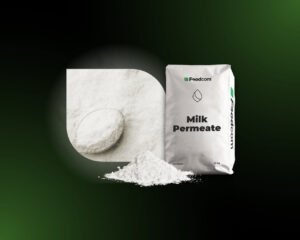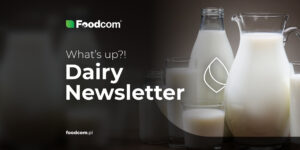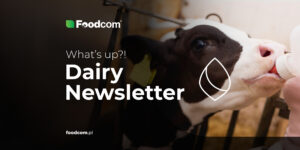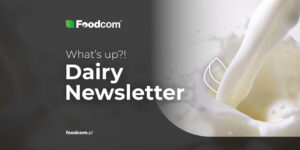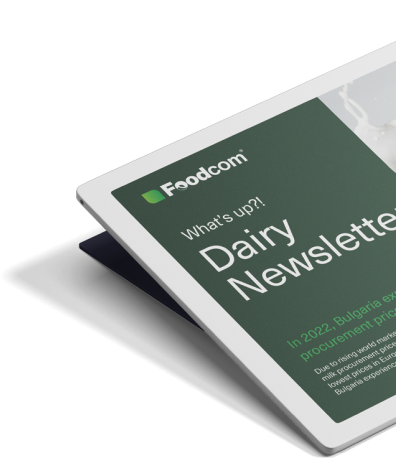- Europe is struggling with a milk surplus – prices for powder, cheese and fats continue to fall.
- Cream is catching its breath after September’s turmoil, but the market is still far from stable.
- The beginning of the fourth quarter without a clear direction – trade is cautious, sentiment is volatile.
- Contrasts on the global stage – record profits in New Zealand, problems in Spain and Switzerland.
Welcome Partners!
Welcome back to our newsletter!
The European market is still drowning in oversupply. Powder and cheese prices are falling and the fats segment remains volatile. The global dairy scene remains full of contrasts, with New Zealand celebrating record profits, while Spain faces an epidemic crisis and Switzerland a financial crisis caused by US tariffs. Some are counting profits, others are trying to cut losses. It is in such mixed moods that we begin the fourth quarter.
Scroll down for detailed market data and forecasts.
Milk powder
The skimmed milk powder(SMP) market in Europe is still looking for an equilibrium point. Prices remain in the range of €2100-2150 per tonne and trade is proceeding cautiously – supply is plentiful, while buyers are in no hurry to make decisions. The end of the season is not bringing the expected recovery as stocks remain high and processors are looking for ways to manage the excess raw milk.
In Oceania and Australia, the SMP market is more balanced, with prices in the €2100-2200 per tonne range. Good weather and a steady pace of production are keeping supplies stable, and there are first signs of a rebound in Asia, with an increasing number of enquiries from southern countries, which could herald more trading activity. In the United States, prices remain in the region of €2180 per tonne, with the market maintaining a calm rhythm after earlier fluctuations.
In the whole milk powder(FCMP) market, quotations have weakened slightly, with prices around €3650-3750 per tonne in Europe and €3100-3200 per tonne in Oceania. Despite the slight adjustments, the mood remains moderately optimistic. Producers are hoping that increased importer activity in Asia and a seasonal rebound in demand in the fourth quarter will help stabilise prices in the final weeks of the year.
Cheese
The cheese market in Europe remains weak, with quotations continuing to fall. Gouda 48% cheese prices remain in the range of €3100-3200 per tonne, down further from the previous week. Edam is keeping prices at a similar level to Gouda. Processors are signalling limited buying activity and exports to third countries remain difficult at current price levels. The oversupply of milk in the region continues to weigh on the market, and low retail prices in Germany suggest that pressure on producers may continue into October.
Mozzarella remains on a downward trend. Current block prices are in the €3,000-3,200 per tonne range, implying further reductions. Despite isolated signs of improving demand in southern Europe, the market remains cautious. Producers are squeezing margins to maintain liquidity in the trade and transactions are mainly spot, without longer contracts.
In the cheddar market, the situation is similar. In Europe, prices have fallen to €3550-3850 per tonne, reflecting a soft market and the end of the season in Ireland. In Australia and New Zealand, quotations remain in the region of €3900-4100 per tonne and in the US there has been a slight rebound to around €3300 per tonne after earlier falls. In the coming weeks, the market will remain influenced by seasonal retail demand, which may partially stabilise prices in the fourth quarter.
Fats
Butter prices in Europe have halted their earlier decline and stabilised in the range of €5300-5500 per tonne. After the dynamic discounts of September, the market has found a temporary equilibrium, although demand remains cautious. The high supply of raw material is limiting the potential for further growth and processors stress that, with current energy and logistics costs, maintaining profitability requires a very selective approach to contracts.
On international markets, the situation is mixed. In Oceania, butter prices remain slightly higher than in the European Union, between €5650-5750 per tonne, with limited spot trade. In the United States, quotations have rebounded to around €3240, after an earlier, significant drop in the second half of September. Differences between regions remain large, however, due to different supply conditions and production costs.
In the anhydrous milk fat(AMF) market, prices remain stable and relatively high in relation to butter. International trade is limited and most transactions are for short-term supply. Producers expect more export demand to emerge with the end of the year and increased activity in Asia, which could stabilise the global dairy fat market in early 2026.
Liquids
After several weeks of declines, cream prices in Europe have rebounded slightly, reaching €6000-6200/MT. The market reacted to the limited supply of raw material after the September turmoil, allowing a symbolic strengthening of quotations. Demand from processors remains moderate, but buyers are gradually returning to the market, hoping for stabilisation in the second half of October.
The market for concentrated skimmed milk(SMC) is more mixed. Prices are between €1,300 and €1,600 per tonne, depending on dry matter content and destination. The high availability of milk is encouraging some plants to increase SMC production at the expense of whey, which, with current price relations, brings a better return. Supply remains plentiful and most trade is concentrated in the EU market.
On world markets, the situation is stable. In Oceania, cream prices remain around the same level and processors are reporting increasing interest in supply from South East Asia. In the United States, the market for liquid components remains well balanced, with production remaining high and local demand remaining stable. Global trade is proceeding without major disruptions and relatively low transport costs are helping to keep supplies flowing.
Whey powder
The whey market in Europe remains under pressure, with prices showing no clear signs of rebounding. Food grade whey (SWP) remains below €1,000/MT, while feed whey is priced in the €800-850/MT range. Oversupply continues to have a negative impact on trade sentiment, with exports to China clearly weakening, with imports there falling by around 37% year-on-year. Demand in Europe remains subdued and producers are reporting low margins. An increasing number of plants are therefore diverting raw material to the production of protein concentrates to maintain profitability.
The whey protein concentrate(WPC 80) segment is showing more resilience. In Europe, prices remain in the region of EUR 12,000/MT, supported by stable demand from the nutrition industry and functional ingredient manufacturers, despite a slowdown in production in Germany and France. Buyers are increasingly securing contracts for the fourth quarter, indicating continued confidence in demand for the rest of the year. In the US, WPC 80 remains significantly cheaper at €9000-9300/MT, with a good balance between supply and demand.
Whey protein isolate(WPI) remains the strongest segment of the market. In Europe, prices are in the range of EUR 19800-20500/MT, driven by limited raw material availability and stable demand from the sports nutrition and functional food sectors. In the US, WPI values remain slightly below EUR 19000/MT, with buyers still preferring proven quality and reliable supply chains.
In contrast, the permeate and lactose market continues to weaken. In Europe, permeate is quoted at around EUR 800/MT, while in the US it remains lower at EUR 480-500/MT. Lactose costs EUR 700-750/MT in Europe and EUR 620-640/MT in the US. Weak import demand from China and persistent tariffs on US-origin products have redirected some purchases to Europe, although global trade in these components remains limited.
What’s new?
Switzerland
New US tariffs on cheese imports have seriously shaken the Swiss dairy market. Restricted exports have led to an oversupply of milk, with procurement prices falling by up to 30 cents per litre. As a result, many producers are facing herd reductions, and estimates suggest that around 25,000 cows may be culled, a significant increase from typical annual levels. For Swiss farms, which for years have relied on exporting cheeses such as Gruyère and Emmental, this is a major economic challenge. In response, Interprofession du Lait has launched an 11 million Swiss franc aid fund to support butter and cream exports and ease tensions in the cheese market. These measures are expected to stabilise the price situation and limit the impact of the crisis. However, industry representatives warn that if trade tariffs with the US continue, Swiss producers could face a permanent loss of competitiveness on foreign markets.
New Zealand
New Zealand’s dairy sector has completed an exceptionally successful year in which effective cost control has enabled record profits. Figures from the Waikato region show that cash profit increased by 119 per cent. Producers are increasingly focusing on cost optimisation rather than expansion, allowing them to respond more flexibly to changing market conditions. Particularly impressive results were achieved by farms operating in a 50:50 sharemilking model, where income after accounting for costs increased by as much as 356 per cent! In this system, the herd owner works in partnership with the farm tenant, and the two parties share both income as well as capital expenditure and operating costs. Such a model promotes greater financial discipline and more sustainable production management. Experts emphasise that maintaining the current cost strategy with a favourable macroeconomic environment could further strengthen the position of New Zealand producers in the global milk market in the coming season.
Spain
The first case of Lumpy Skin Disease in Spain has been confirmed in Catalonia. This highly contagious viral disease, mainly transmitted by insects, poses a serious threat to livestock farming, as it leads to a decrease in milk yield, reproductive losses and restrictions in the trade of live cattle. Veterinary authorities immediately introduced countermeasures, including the elimination of the infected herd and restrictions on the movement of animals within a 20-kilometre radius of the outbreak. Additional sanitary controls and monitoring of disease vectors are being carried out in the wider zone. Due to the way the virus is spreading, experts warn that the disease could also spread to other southern European countries, including France and Italy, which could disrupt cattle trade and increase cost pressures throughout the dairy chain.
![Europe drowns in milk, New Zealand counts profits. [283rd Edition of DAIRY Bulletin] Europe drowns in milk, New Zealand counts profits. [283rd Edition of DAIRY Bulletin]](https://foodcom.pl/wp-content/uploads/2024/06/Foodcom_SA_Dairy_Newsletter_3-1520x760.jpg)
